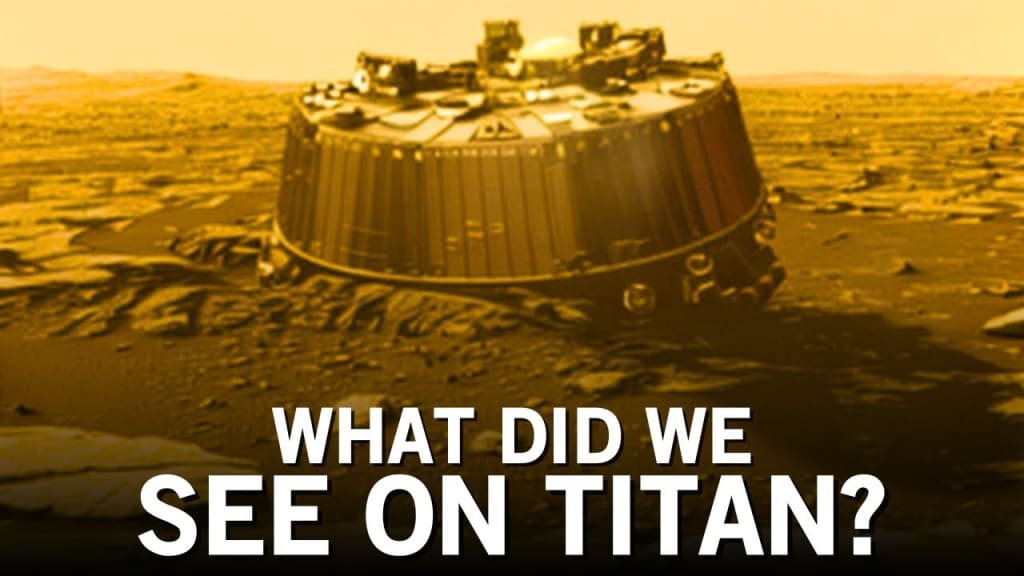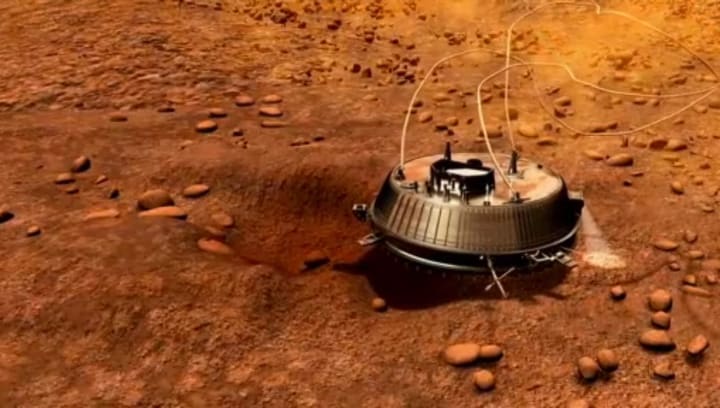Exploring Titan - A Moon with Earth like Atmosphere: Huygens' Historic Mission and the Future with Dragonfly.
"The First And Only Real Images Of TITAN -- Saturn's Largest Moon"

A Momentous Descent
The Huygens probe made history on January 14, 2005. It landed on Titan, which is Saturn's largest moon. This was the first time humanity successfully landed a probe in the outer solar system. The descent took around 2.5 hours through Titan's hazy atmosphere to reach the surface.
Titan's Enigmatic Features: A World Unlike Any Other
Titan is bigger than Earth's moon and larger than the planet Mercury. It has a substantial atmosphere and is the only moon in the solar system that does. It also has standing bodies of liquid on its surface, such as rivers, lakes, and seas. Earth is the only other world with these features.
Huygens' Dramatic Landing: Unraveling Titan's Secrets
As the Huygens probe approached its landing on Titan, a sequence of parachutes unfurled to decelerate the probe at an altitude of approximately 160 kilometers above the moon's surface. The scientific instruments aboard the probe were then exposed to Titan's atmosphere, initiating the transmission of valuable data to the Cassini orbiter. With a modest velocity of merely 18 kilometers per hour, Huygens gracefully touched down on the enigmatic terrain of this extraterrestrial satellite.

Unique Challenges and Uncharted Territories: Titan vs. Moon and Mars
Scientists meticulously planned landing sites for moon or Mars missions, carefully scanning the ground using telescopes and orbiters to identify hazardous areas and safe zones. Flight engineers extensively studied maps and prepared accordingly. However, Titan, Saturn's largest moon, remained a perplexing enigma. Apart from a brief encounter with Voyager 1 in 1980, limited information was available about this intriguing celestial body.
Huygens' Scientific Contributions: Changing Our Understanding of Titan
The findings from the Voyager mission revealed that Titan bears a striking resemblance to Earth, surpassing any other planet in our solar system. The profusion of carbon elements on Titan presents a unique opportunity to investigate the fundamental organic chemical reactions that occurred on our own planet approximately 4 billion years ago.
A Step-by-Step Descent: From Atmosphere to Surface
Upon entering the atmosphere, Huygens was enveloped within a heat shield to safeguard it from the intense pressures of entry. Following its passage through a hazardous region, it discarded the rear cover and unfurled its expansive parachute. Once it achieved stability, Huygens shed its front heat shield, poised to commence its scientific expedition. Without delay, Huygens initiated its analysis and recording processes, capturing its inaugural image while floating at an altitude of 89 miles (143 kilometers) above the surface of Titan.
Titan's Varied Landscape: From Riverbeds to Sand-Like Plains
The surface images depicted a level expanse scattered with small stones, along with indications of liquid affecting the landscape in the recent history. Further information substantiated the presence of lakes containing liquid hydrocarbons in the polar areas of Titan. Huygens' initial photographs altered the scientific community's comprehension of Titan indefinitely. The images captured by the probe revealed distinct riverbeds and channels etched into the surface of Titan.
Dragonfly: The Next Frontier
At present, researchers are actively engaged in developing a fresh expedition to investigate Titan, and they intend to employ a specialized drone named Dragonfly. Unlike a small drone typically seen in backyards, Dragonfly will resemble a flying mass rover and will undertake several dozen brief flights across Titan over a span of 2.7 years.
Dragonfly's Mission: Seeking Life's Ingredients on Titan
Dragonfly is heading towards the Selk impact crater, where scientists speculate that the convergence of three essential components for life might have occurred. This location shows indications of past liquid water, as well as the presence of organic molecules and sunlight-derived energy, which are also found in other areas of the surface. Additionally, there is optimism that Titan's presumed subsurface ocean might reach a sufficient level to interact with these vital ingredients, potentially creating an environment conducive to life beneath the towering sand dunes and methane rivers.
Conclusion: Titan's Mysteries Unraveled
Dragonfly is set to launch in 2024 and arrive at Titan in 2036. So our dreams of playing in an early Earth sandbox will have to wait a while longer. But when we do get to Titan, whatever we learn is going to give us game-changing insight into the origin of life as we know it.
Stay tuned for upcoming announcements.
About the Creator
Sai Kiran
EVERYTHING, EVERYONE ALL AT ONE PLACE. LET's EXPLORE EVERYTHING TOGETHER.
Enjoyed the story? Support the Creator.
Subscribe for free to receive all their stories in your feed. You could also pledge your support or give them a one-off tip, letting them know you appreciate their work.






Comments (1)
This writing was outstanding. I liked it a lot and couldn't find any flaws. You're welcome! on vocal May you have a day full of smiles, always!